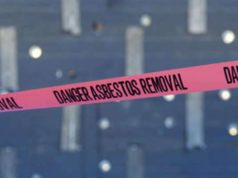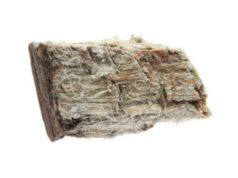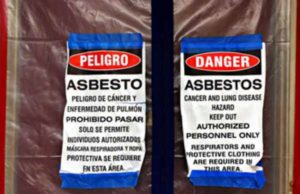
What is Anthophyllite Asbestos?
Anthophyllite asbestos is a fibrous mineral that varies in color from grey to green and sometimes shades of brown. In powdered form, it will range from white to grey. If is usually found in fibrous form, like so many other forms of asbestos. It is magnesium-rich and can be found all over the United States. This form of asbestos is the result of metamorphic pressure on talc rock. Anthophyllite asbestos is normally brittle but can become elastic with sufficient manipulation in its non-crystal fibrous form.
The chemical formula for Anthophyllite asbestos is:
(Mg,Fe)7 Si8 O22 (OH)2
How was Anthophyllite asbestos used?
Despite being fairly common in the US, Anthophyllite asbestos was more commonly mined in Finland and Japan. There were only smaller mines in North Carolina and Georgia for this mineral. Anthophyllite asbestos, as it is an insulator and fireproofing agent, is commonly found in flooring. Anthophyllite asbestos has also been used in cement tiles, body powder and sealant. Most forms of asbestos, including any new asbestos products were banned by the US government after 1989. There is no complete ban on asbestos in the US, compared to laws in other countries.
As talc is an important formative part of Anthophyllite asbestos, there carries the risks that trace amounts of this mineral was present in talcum powder. Anthophyllite asbestos may have also made it in to the gardening material vermiculite.
Anthophyllite asbestos was by and large not used commercially and therefore offers a lesser risk of exposure through everyday contact than other typical types of asbestos. You are much more likely to encounter any of the other five types of asbestos.
Is Anthophyllite asbestos exposure fatal?
Yes. As with all types of asbestos, Anthophyllite will cause mesothelioma and other lung cancers. Mesothelioma is a cancer of the lungs and diaphragm and affects the inner lining of these organs. Tiny crystals from the asbestos penetrate the soft tissue and remain embedded in there for a number of years. The hazardous material will remain latent for abut forty years before the patient begins to suffer from diminished lung function. The inner membrane will have hardened, which hampers breathing. In addition, fluid will collect in the lungs. Those that suffer from mesothelioma slowly suffocate due to the shutdown of their lungs.
If there are Anthophyllite asbestos materials in my house, should I remove it?
Yes, this material should be removed, but not by you. The greatest risk of exposure to harmful asbestos is during abatement, when micro particles will be released into the air. Although these particles are indiscernible to the naked eye, it will still penetrate the lungs as mentioned above. Only trust an asbestos abatement professional to remove the Anthophyllite asbestos.
How do I limit my exposure to Anthophyllite asbestos?
Clearly, leaving the hazardous environment would be the best option. Masks have proven to be less than effective at preventing exposure to micro particles. Those that frequently work with asbestos abatement must now thoroughly scrub themselves to prevent dangerous residue and sterile any equipment they work with. Those that have been exposure to Anthophyllite asbestos are best served by quitting smoking as this increases the risk factors for developing mesothelioma and lung cancer dramatically.
Asbestosis describes the condition where the body, being unable to break down chemically resistant asbestos will become inflamed, causing serve respiratory problems, coughing and clubbed fingers.
Do I have legal recourse against anyone that exposes me to Anthophyllite asbestos?
This depends on if you have development an illness due to the exposure. All individuals will be exposed to asbestos at some point, as it is naturally occurring. That important factor in this case will be proving that specific exposure, while in the course of working for an employer or living in a residence, caused the asbestos related illness and as a result, should compensate your for damages.
To find a lawyer that will pursue litigation based on asbestos exposure, use the Find Attorneys function of this site to receive more information. Additionally, you can consult the state bar association directory for your state. Lawyer referral services also exist to guide clients to lawyers, and there will generally be no charge for the initial consultation by a mesothelioma patient.
Litigation for asbestos exposure will seek to compensate you for losses sustained due to medical bills, lost wages and other damages. You can also seek non-economic damages for pain and suffering related to the guilty party’s failure to provide a standard of care and concern for your health and safety.




























